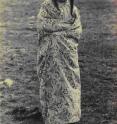Cultural identity of indigenous society of Patagonia restored
Argentinean and Spanish researchers have shown that indigenous societies in Patagonia, the southernmost region of the Earth inhabited by humans over the past 13,000 years, were not static and marginal as had always been thought, but in fact had high levels of social organisation. The latest study by this team, published in the journal Arctic Anthropology, breaks down false myths and gives these societies the historic recognition they deserve. "Was Patagonia a desert?" Using this question as its starting point, the Argentinean-Spanish research team has studied the development of ethnicity in Patagonia, one of the last regions of the world to be occupied by human beings, around 13,000 years ago according to radio carbon dating of archaeological remains in the region. The study, published in the journal Arctic Anthropology, overturns the traditional view of these societies.
"We started our study looking at the situation of the indigenous society today, which is suffering from a loss of cultural identity and a high degree of mixture between populations due to numerous migratory movements and the pressures of urban life", Juan A. Barceló, lead author of the study and an archaeologist and researcher at the Autonomous University of Barcelona (UAB), tells SINC.
Documentary evidence to date has held that the region was occupied by primitive hunter-gatherers who started to "die out" and disappeared leaving behind a "desert". However, even though the indigenous population subsists in marginal populations today, this study shows that it has a history of its own.
Using ethnographic documents containing the life stories of old people who lived as nomadic hunter-gatherers as children, as well as information sources from travellers and naturalists in the 19th Century, the social scientists used specially-created computer programmes to study the dynamics of indigenous populations.
"Going beyond the common areas of information, we incorporated archaeological, anthropological and ethno-historic data to highlight the profound social complexity and economic, social and reproductive strategies of these apparently extremely simple human communities", the researcher says.
One hundred years of resistance to colonisation
Prior to European colonisation, the indigenous population had highly ingrained levels of social hierarchy. "They had relatively well evolved leadership systems, social predominance was transmitted via parentage, and wealth was concentrated, particularly in the form of thousands of heads of cattle or horses", says Barceló.
The team of experts explains that the indigenous societies had complex social and political organisation, being able to mobilise thousands of warriors.
"When they were fighting against the pressure of industrial societies they were able to call up military bands of more than 1,000 warriors, bringing together forces from distant regions and with different languages and identities", the expert explains.
Barceló says this enormous mobilisation capacity held the ever-increasing pressures of industrial society at bay for almost 100 years "until the colonists started to use canons, rifles and sabres, totally wiping out certain ethnic groups".
Recognising the past
The view of these indigenous populations as marginal people who all spoke the same language is erroneous. Some historical studies on southern languages differentiate between 30 separate languages and dialects, which were inter-related to various degrees.
"Linguistic complexity was probably much greater before European contact, since a significant feature of colonisation was the trend towards linguistic homogeneity", according to the study.
The researchers also found these to be "extraordinarily dynamic" societies that adjusted their internal characteristics to cope with change. "These were not societies that had a passively adaptation to the land and its resources. Instead, they built their own path through history by taking constant social decisions", says Barceló.
"Aside from the academic community and the general public, this study is aimed at the indigenous societies who have traditionally been denied their own history", the expert concludes.
Source: FECYT - Spanish Foundation for Science and Technology
Other sources
- Cultural identity of indigenous society of Patagonia restoredfrom PhysorgTue, 13 Apr 2010, 15:21:32 UTC
- Cultural identity of indigenous society of Patagonia restoredfrom Science BlogTue, 13 Apr 2010, 14:49:53 UTC
